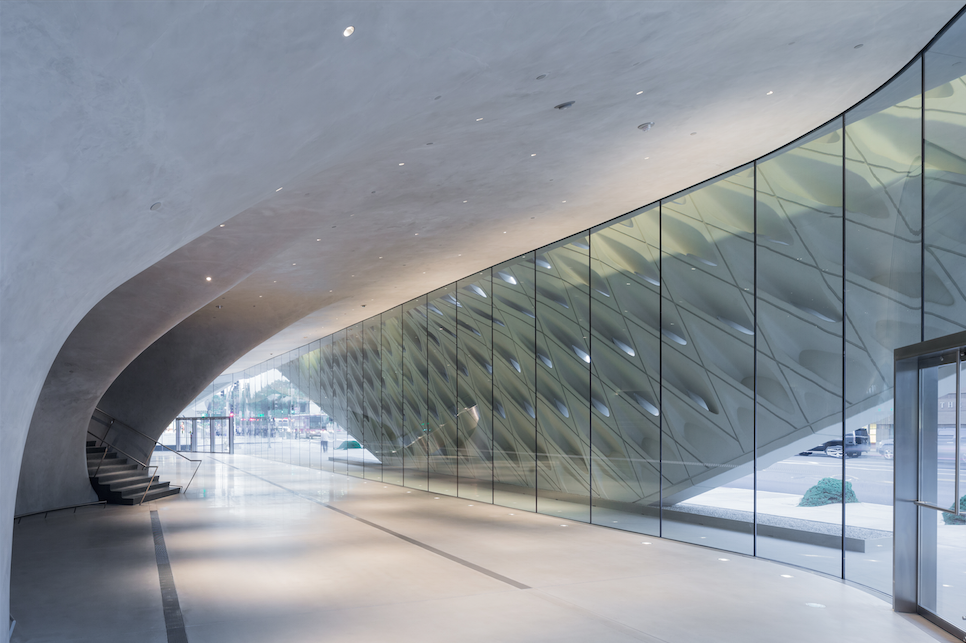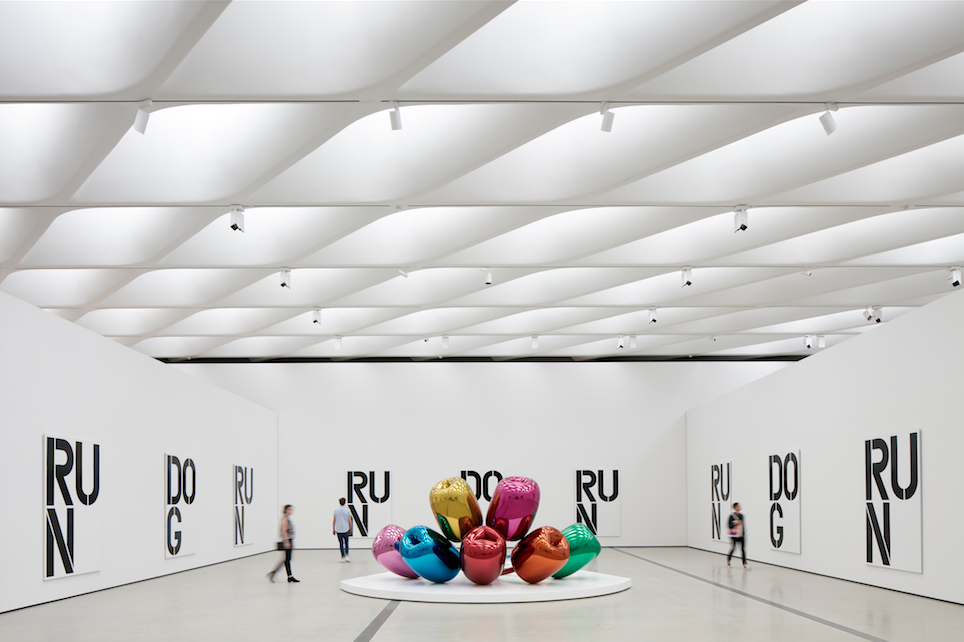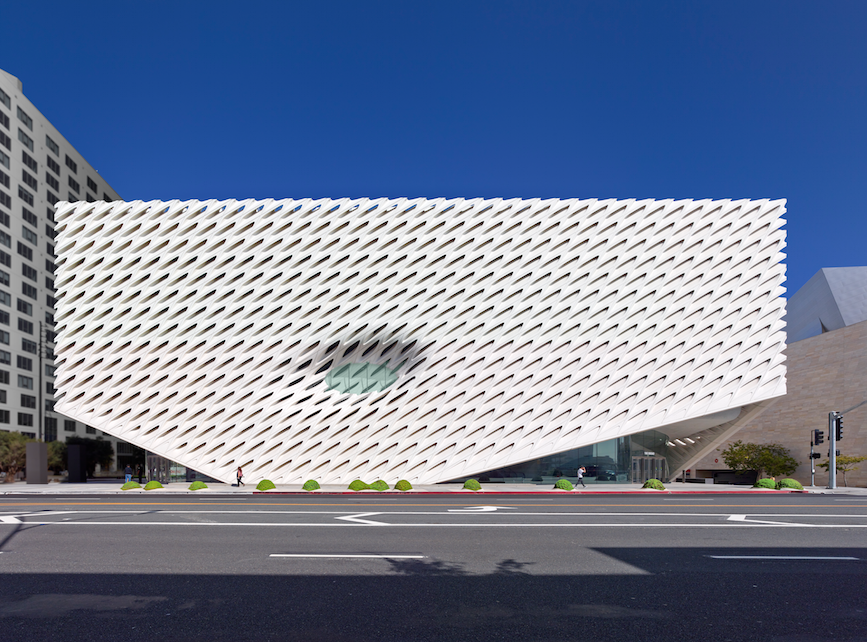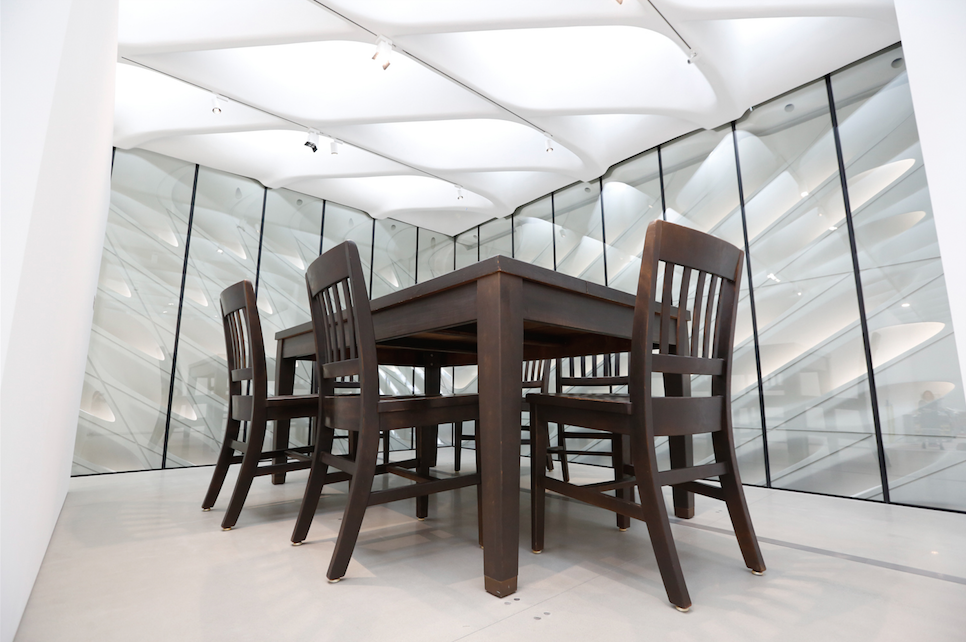
The broad art of architecture
Share
Above: Slit like apertures in the façade filter light to the interior of the Broad museum’s third floor galleries. Images by Iwan Baan, courtesy the Broad and Diller Scofidio + Renfro.
There is simply no point in differentiating between the architecture and art exhibition of The Broad – New York firm Diller Scofidio + Renfro’s latest foray into the world of museum architecture. Nor should there be. Arguably The Broad (pronounced Brode) denotes an exemplar art-exhibiting environment, in that it flexes its own built environment muscle without interfering with the art it purports to showcase. It’s also a pretty good monument to the culture of philanthropy in the US.

The curves of the museum’s lobby transitions visitors from from LA’s sun drenched expanse to a cosseted and cool interior.
The background: for the last 20 years philanthropists Eli and Edythe Broad have been financially supporting, to the point of being largely responsible for, what is now the cultural precinct of Downtown LA. Concurrently their personal collection has steadily amassed more than 2000 works of significance by more than 200 (really) significant artists. A Fortune 500 member, Eli Broad, the son of a trade unionist, earned his wealth through a combination of home building and financial services. His impact on the Californian art scene, particularly the institutions enjoying his largesse, is not to be sneezed at. Architect fees and artworks account for part, but it is his strength of conviction that sees his ongoing insistence on free entry and exemplary contemporary art that has made the impact on Los Angeles as a cultural destination most relevant. That and pockets deep enough to afford the US$140 million build with a reported further US$200 million endowment (Glen Helfand, The Guardian 19 September 2015).
Sufficiently grandiose to achieve destination architecture status, its flair is somewhat moot given its location on Grand Avenue among the cultural Meccas of Frank Gehry’s Walt Disney Concert Hall (Broad took over fundraising in 1996 when it became apparent Lillian Disney’s US$50 million donation was not going to come close – the final sum was US$274 million, plus US$110 million for the car park) and Arata Isozaki’s MOCA or Museum of Contemporary Art (Broad was among three founding patrons, each donating US$1 million).
Architecturally, The Broad is sculptural in form with a skin of concrete modules realised as a stretched honeycomb of slits that make a play of shadows and texture to give the surface substance and a lively quality at odds with the flattening effect of the ever-present Californian sun. The entrance is gently nocturnal, transitioning visitors from the bright glare of LA to a crepuscular and hushed world of contemplation. Sensuous, dare one say, animalistic, curves of dark grey surround and guide the audience through this metaphoric belly of the beast towards the first of the galleries. It also leads to what The New Yorker’s art critic Peter Schjeldahl calls the “low impact joyrides” in the form of the cylindrical glass elevator and 32-metre escalator.
Taking joyride option two, the elevator journey is slightly akin to shifting from a cave to daylight as the walls wrap in on ascent before suddenly opening to the vast and column-less expanse of the main exhibition hall of the third floor. Few art gallery architects get it this right. That said, Renzo Piano is notably lauded for the Menil Collection in Houston, while Tadao Ando’s Naoshima Contemporary Art Museum in Japan includes the museum itself among the artworks. And while of very different styles, these museums are united by their use of natural light. In all three, natural light is augmented with artificial in such a way as to highlight the unique qualities of the artworks, such as materiality, surface, density or the slight variations within the form that denote the artist’s hand. What is harder to quantify is the feeling of the room, which hovers on excessive in size, yet never overwhelms or diminishes. Rather, the glowing white volume envelops and allows a sense of wonder to permeate the experience of walking among magnificent artworks in their natural setting.

Christopher Wool’s black and white “Untitled” work of 1990, along with Jeff Koons’ “Tulips” (1995-2004).
Between ground and third floor lies the vault, which visitors see as a tantalising suggestion of framed portions. Art storage, restoration and administration occupy this portion. Far from the dull innards of most galleries, these elements are drawn into the theatricality of the museum via glass portals that visitors can glimpse, but can’t quite reach from the fabulous curving stairway.
The café and function area (300 capacity) on the ground floor makes an impressive statement. Angled glass and cement walls, polished concrete floors and a ceiling lighting installation suggesting Dan Flavin, signal the contemporary nature of the museum from both sides of the glass, while the outwards view to the street trees serves to locate the gallery firmly in California.
The gallery boasts a who’s who of abstraction that includes Robert Rauschenberg, Jasper Johns, Cy Twombly, Ellsworth Kelly, Albert Oehlen, Mark Grotjahn, Jean-Michel Basquiat, Cindy Sherman, Joseph Beuys, Anselm Kiefer, Georg Baselitz and Thomas Struth. Christopher Wool, John Currin, Glenn Ligon and Kara Walker make a good New York representation, while Ed Ruscha, John Baldessari, Mike Kelley, Chris Burden, Charles Ray, Robert Therrien and Lari Pittman make for a great Los Angeles counterpoint. What makes the collection and space so aptly paired is the depth of collecting. Jeff Koons, for example, has been so extensively collected that whole installations of his work are possible. Similarly, the installation works of Icelandic artist Ragnar Kjartansson and Japan’s Yayoi Kusama, are displayed as the artists intended and all the more fabulous for being so.
There is a singularity of vision to the building that serves the role of an art gallery as cultural destination well. That the interior is perfectly attuned to exhibiting art does something more important, in that the exterior is the advertising, while the interior is the delivery. That it does not disappoint even the most pernickety of art enthusiasts and critics is an achievement beyond measure. It is in fact a combination that bodes well for a lifetime of brilliant exhibitions where the art is shown just as it should be.


















